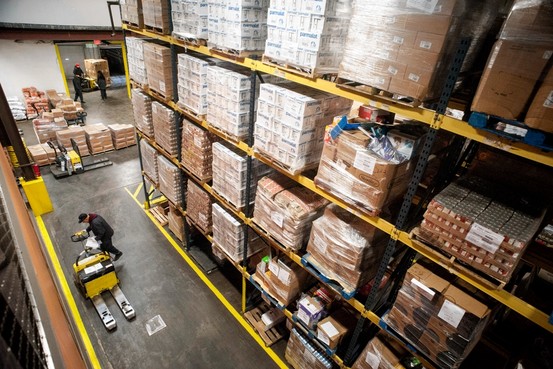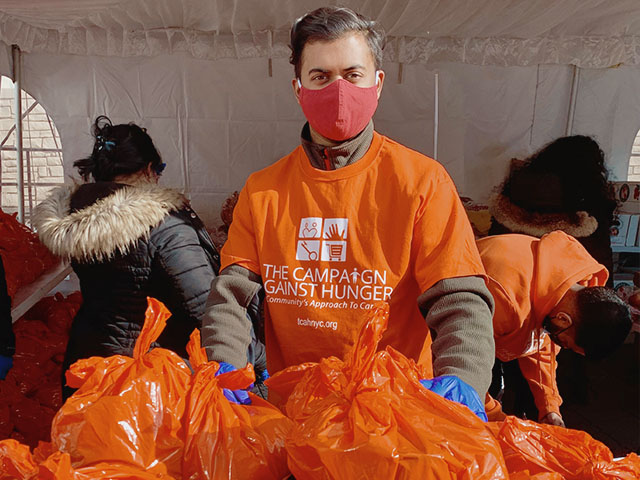Wall Street Journal celebrates Food Pantry Efficiency
Wall Street Journal
Metro Money
Anne Kadet: Feeding New Yorkers With Maximum Efficiency
Last year, 1.4 million New Yorkers—17% of the population—ate from the food bank.
By
Anne Kadet
Dec. 13, 2013 10:22 p.m. ET
A produce selector moves around some of the vast reserves of food at the New York Food
Bank’s warehouse in Hunts Point in the Bronx. Keith Bedford for The Wall Street Journal
Tamara Dawson buys groceries every Tuesday morning and, like many busy New Yorkers, she
shops online. This week’s order was on the small side. After checking the specials, she loaded
her cart with 192 boxes of corn flakes, 16 cases of beef, 180 pounds of chicken, 432 bags of
pasta and 15 cartons of brown rice. The store flashed a bonus offer: Would she like 50 cases of
mystery produce delivered at no extra charge? Absolutely. “It’s usually good stuff,” she says.
She scheduled delivery and viewed the total: 2,118 pounds of food for $240.81.
Ms. Dawson wasn’t stocking her kitchen, obviously. She was shopping for her food pantry, the
Bed-Stuy Campaign Against Hunger. Her “store” of choice? The nonprofit Food Bank for New
York City, a Fresh Direct for local shelters, soup kitchens and senior centers.
When most folks hear “food bank,” they envision a modest pantry staffed by volunteers in
denim. And that may be the case in some towns, but not in New York.
Want some crazy numbers? Last year, 1.4 million New Yorkers—17% of the population—ate
from the food bank. Its trucks deliver 74 million pounds of food a year to 1,000 partners. That’s
400,000 meals a day: more than the number served by the city’s 240 McDonald’s. I’m not sure
this is something to brag about, but our food bank is the largest in the world.
It may also be the most sophisticated. Its downtown offices employ teams of pointy-headed
researchers, p.r. mavens and nutritionists, while its Harlem soup kitchen serves as a test lab.
But the operation’s true heart is the Bronx warehouse, a 90,000-square-foot distribution facility
that rivals an Amazon.com fulfillment center for its complexity and scale.
It doesn’t look like much from the outside. The Hunts Point facility is a windowless cement
affair overlooking a huge parking lot. The action’s inside, a raucous space buzzing with logistics
wizards, purchasing agents and warehouse pickers racing motorized forklifts through three-
story canyons of apple juice and canned salmon. It’s especially busy during the holidays, when
heating bills rise and families have less cash for food.
This week, CEO Margarette Purvis gave me a tour. The daughter of a popular Memphis news
anchor, she has the radiant enthusiasm of someone who swallowed the sun and ate the
moon for dessert; her favorite expletive is the endearingly mild “doggone!” Still, she seems
comfortable in the rough-and-tumble warehouse, with its half-acre walk-in cooler and roaring,
12,500-square-foot freezer stocked with chicken and oxtail. “I don’t know why people don’t
think food banking is sexy,” she says. “I think it’s very sexy!”
She introduced me to picker Jimmy Johnson, a friendly man in a gray jumpsuit whose right arm
looked like something from “Terminator 2.” His wrist was saddled with a black digital processor
wired to an optical scanner mounted on his forefinger; the screen displayed an order he was
assembling for an Upper East Side shelter. “I gotta get 10 cases of peanut butter, four extra-
long grain rice, 10 spaghetti, four lentil and that’s it!” he said.
The central system had calculated the most efficient route through the warehouse, taking into
account which items were heaviest and should be loaded first. Mr. Johnson scanned each case
before ferrying the order to the loading dock, where it was bound in shrink wrap and readied
for one of the day’s 200 deliveries.
I didn’t get much time with Mr. Johnson—he’s supposed to pick 225 cases an hour with
zero error. And there are greater efficiencies on the way, says Food Distribution VP Dan
Cinquemani. Recently, a pro bono team of Toyota engineers descended on the bank’s
soup kitchen with their stopwatches and notepads; they cut 72 minutes off the soup line.
Now, they’re giving the warehouse similar scrutiny. Another goal: reduce the SKU count so
wholesale items can be purchased in greater quantities at lower prices.
Where does all this food come from? Half the $4.2 million inventory comes from the
government, says Mr. Cinquemani—think commodities like chicken quarters and dried milk.
Packaged goods like cereal and canned stew are purchased wholesale. Direct donations come
from food drives, nearby warehouses and companies like Target, Fresh Direct and Sysco. Even
local farmers get in on the act.
Some donations are difficult to process. We stopped by the repacking room, where volunteers
were resorting a huge food drive delivery. I peeked into a box: grape jam, Velveeta spread,
beans, gravy mix, canned peas, gluten-free toaster pastry. Bon appetite!
To one side was a dumpster where volunteers were tossing rejects. It’s hilarious what people
donate. There was a half-eaten package of dried mango and a tin of sardines with the label
missing. Ms. Purvis noted the expiration date: March 2000. The worst donation she’s seen? A
half block of cheese, complete with human teeth marks.
Food pantries say demand is highest for protein, fruits and vegetables—healthy food that
costs a lot at the supermarket—and Ms. Purvis is proud of the fact that the bank delivers
15 million pounds of fresh produce annually. “Look at this!” she says, grabbing a green
Kirby cucumber. “This right here, this is dignity!” She whacked the fruit against her palm for
emphasis. “When you’re poor, the first thing to leave your menu is the doggone produce.
People will go crazy for this!”
The Food Bank has come a long way since its 1983 launch, when it distributed 500,000 pounds
of food to 95 programs. There wasn’t even a delivery service. Nuns drove to the docks to
retrieve their orders.
No one wants to return to those low-tech days, not that it’s possible. There may be no tougher
customer than a soup kitchen worker. If a delivery comes late, says Ms. Purvis, “Those sweet
little church ladies will give you an earful!”
But that’s rare. Swami Durga Das, who shops the bank daily for the River Fund, his Richmond
Hill pantry, says that even as demand grows, deliveries have only gotten more efficient, reliable
and nutritious. And when the job is as crucial as feeding New Yorkers who can’t afford a decent
meal, it’s good to know there are competent folks in charge: “They’re better than the cable guy,
that’s for sure!”





